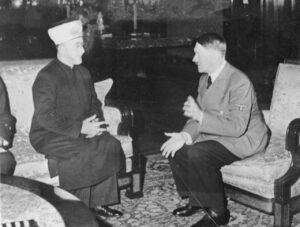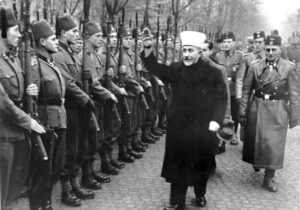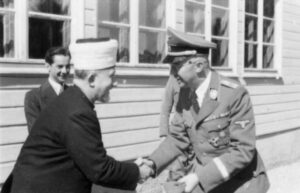- 3.4K
- 3.4KSHARES
The New York Times has described a notorious partnership between Nazi Germany and an antisemitic Palestinian leader as a collaboration that targeted “Zionism,” as opposed to Jews.
The claim, which appears in the Oct. 6 story “Saudi Prince Accuses Palestinian Leaders of Failing Palestinians” by Isabel Kershner and Ben Hubbard, whitewashes the antisemitism of both the Nazis and their Palestinian ally, Amin al-Husseini, and downplays the nature and extent of their alliance.
The offending sentence appears in a passage that seems meant to push back on a Saudi prince’s criticism of Palestinian leaders and, specifically, of the links between Hitler and al-Husseini:
Prince Bandar offered a rambling and selective history of the Palestinian struggle, saying that the Palestinians “always bet on the losing side.”
His survey, interspersed with archival images and footage, cited the contacts between Haj Amin al-Husseini, the grand mufti of Jerusalem and an early Palestinian nationalist leader, and the Nazis in the 1930s, adding, “we all know what happened to Hitler and Germany.”
The prince also blasted Yasir Arafat, the late Palestinian leader, for embracing the Iraqi dictator Saddam Hussein after Iraq invaded Kuwait in 1990, despite Kuwait’s record of welcoming the Palestinians. And he accused Mr. Arafat’s P.L.O. of working harder to take over Jordan and Lebanon than to liberate Palestine.
While there is broad agreement that Mr. al-Husseini collaborated with the Nazis against Zionism, historians differ on the significance of his relationship with Nazi leaders.
The newspaper doesn’t elaborate on which historians disagree with each other, nor on what about the “significance of the relationship” they disagree. It’s unclear, in fact, what the point of the passage is, other than to defend al-Husseini and his alliance with Hitler as being something less than antisemitic.
Whatever the motivation of the Times authors, their passage is egregiously misleading, effectively false, and a whitewash of antisemitism. Both al-Husseini and, of course, the Nazis were rabidly antisemitic, and both were motivated in their collaboration by that antisemitism. To be anti-Zionist as well as antisemitic does nothing to erase or override the antisemitism, and in fact is perfectly consistent with it.
Al-Husseini was clearly anti-Jewish, appealed to the Nazis with that antisemitism, and has publicly called for the killing of Jews everywhere.
- The United States Holocaust Memorial Museum characterizes al-Husseini as “a vicious antisemite and actively supportive of Nazi Germany’s efforts to annihilate world Jewry.”
- Yad Vashem states that the Palestinian mufti was motivated, inter alia, to “lend his support to the ‘Final Solution.’”
- Nazi official Wilhelm Melchers is quoted as stating after the war, during testimony about al-Husseini, that “the mufti was an accomplished foe of the Jews and did not conceal that he would love to see all of them liquidated.” (Jennie Lebel, The Mufti of Jerusalem: Haj-Amin el-Husseini and National Socialism, pg. 255.)
- Jeffrey Herf, a professor of German history, wrote of al-Husseini that “In Hitler and the Nazis he recognized ideological soulmates who shared his profound hatred of the Jews, Judaism and Zionism.”
- In his book on Nazi propaganda in the Arab world, Herf describes al-Husseini’s “intense hatred of Jews,” quoting the Palestinian leader as referring to the “overwhelming egoism” of Jews, who “lived like a sponge among peoples, sucked their blood, seized their property, undermined their morals,” and so on. Jews had “tormented the world for ages” and were “the enemy of the Arabs and of Islam since its emergence,” al-Husseini argued.
- In al-Husseini’s 1937 text “Islam and the Jews,” he charges Jews with perfidy going back to the time of Muhammed:
“The battle between Jews and Islam began when Mohammed fled from Mecca to Medina… In those days the Jewish methods were exactly the same as they are today. Then as now, slander was their weapon. They said Mohammed was a swindler… They tried to undermine his honor… They began to pose senseless and unanswerable questions to Mohammed… and then they tried to annihilate the Muslims. Just as the Jews were able to betray Mohammed, so they will betray the Muslims today… the verses of the Koran and the Hadith assert that the Jews were Islam’s most bitter enemy and moreover try to destroy it.” - Al-Husseini also called on his followers to “Rise as one and fight for your sacred rights. Kill the Jews wherever you find them. This pleases God, history and religion. This serves your honor. God is with you.”
That should suffice for demonstrating Husseini’s animus to Jews qua Jews. If the idea of these egoistic, immoral, blood suckers living in Palestine especially excited his hatred — and indeed, he lobbied on multiple occasions to prevent thousands of Jewish children from escaping their fate in Nazi Europe by gaining refuge in Palestine — this is but a logical extension of his antisemitism.
There should be no need to likewise make the case that any Nazi concern with Zionism also followed directly from their views about Jews in general. But if Times journalists need a refresher, they can consult Heinrich Himmler’s telegraph to his friend al-Husseini, in which the leading Nazi describes his support for the Arab fight against Jewish “invaders” in Palestine as stemming from the Nazi’s “struggle against world Jewry.”
“The joint recognition of the enemy and the struggle together against it are what build the solid basis between the National Socialists of Greater Germany and freedom-loving Muslims of the world,” Himmler continued.
Al-Husseini’s anti-Zionist antisemitism sought to condemn countless Jewish children to death at the hands of the Nazis. But make no mistake: Thanks to the New York Times‘ campaign to normalize and boost anti-Zionism, its recasting of the Nazis and al-Husseini as collaborating merely “against Zionism” will be seen by some of its readers as exculpatory. This is the same newspaper, after all, that not only hosted a debate on its pages about whether Israel should continue to exist, but that stacked the deck so that the defenders of Israel’s existence were outnumbered. It is the same paper that has repeatedly turned its Opinion pages over to activists, from Ian Lustick to Muammar Qaddafi to Ali Abunimah to Peter Beinart, calling for the Jewish state to be wiped off the map. Beinart’s anti-Zionist Op-Ed seemingly earned him a job offer from the New York Times Opinion department within days of its publication.
A Partnership Against Anti-Nazi Partisans, Too
The New York Times‘ characterization of a partnership “against Zionsim” was further mistaken because the collaboration between Husseini and the Nazis, even if motivated by antisemitism, spilled into other realms not directly related to either Jews or Zionism. The US Holocaust Museum has noted, for example, the well-documented role al-Husseini played in recruiting Bosnian soldiers for the Nazi’s Waffen-SS. He collaborated with the Nazis, in other words, not only against Jews, but also against partisans in Europe, who were killed by soldiers that al-Husseini helped recruit.
Bad Habits are Hard to Break
What could make the newspaper whitewash all of this, and recast the partnership between the Nazis and al-Husseini as strictly anti-Zionist? The New York Times has an Israel problem; it has an antisemitism problem; and it has a problem reporting forthrightly on Palestinian antisemitism and anti-Jewish violence — extending, apparently, even to leaders who supported and eagerly collaborated with the Nazis.
That is apparently why the paper made a point of signaling to readers that the Saudi Prince’s criticism of past Palestinian leaders is invalid, and that al-Husseini wasn’t antisemitic.
It’s telling, for example, that the New York Times characterized Bandar bin Sultan’s criticism as “a rambling and selective history,” when that same newspaper had previously described a conspiratorial, error-filled, and anti-Jewish rant by current Palestinian leader Mahmoud Abbas as nothing worse than a “lengthy history lecture.” What makes a history “rambling and selective,” then, is neither bloviation nor inaccuracy. It is the focus of that history. You can fabricate Jewish history all you want. Just don’t shine too hard a light on Palestinian leaders.
Again and again, in fact, New York Times journalists have engaged in advocacy journalism to protect Palestinian decision-makers from criticism. In 2014, after a Palestinian terrorist slaughtered Jews who were praying in a Jerusalem synagogue, editors inexplicably cut from their story on the incident any reference to US Secretary of State John Kerry blaming the massacre on Palestinian incitement. (Kerry’s damning condemnation, in fact, was replaced by a Palestinian accusation that Israel is guilty of incitement.) Last year, a passage explaining that Islamic Jihad is “listed as a terrorist organization by many countries” — an accurate and relevant piece of context — likewise mysteriously disappeared from a Times article.
A recent story about one of Hamas’s rocket barrages toward Israeli towns and cities, which are war crimes, excused the terror group’s violence as coming from a party that “can express its impatience with weapons,” while the reporter pretended that if such a barrage were to kill many Israeli civilians, it would surely be from a “stray” rocket — as if Hamas doesn’t intentionally fire into the heart of Israeli cities.
The Times was quick to pounce on Israeli prime minister Benjamin Netanyahu’s critique of a US ambassador, in which he charged the ambassador with saying something “unacceptable and incorrect.” It covered the incident in a news story and slammed it in an editorial. But when, not long afterward, Mahmoud Abbas called a US ambassador a “son of a dog, the newspaper looked the other way. The well-documented and openly acknowledged Palestinian payments to terrorists serving time in Israeli prisons, which are thought to incentivize anti-Israel violence, was described by the newspaper as a “far-right conspiracy” theory. The Times has described Palestinians killed during a gunfight with Israeli soldiers as mere “protesters” shot down by the Israelis.
The newspaper consistently downplays Palestinian agency and responsibility for the conflict in this way. It seems even Palestinian allies of the Nazis are entitled to such treatment.
Update: The Mufti’s Pamphlet
Al-Husseini and the Nazis took every opportunity to spread anti-Jewish propaganda, including by distributing a pamphlet that has been described as seminal in the development of modern Islamic antisemitism.
Researcher Matthias Küntzel characterizes the 1937 pamphlet as “the first text that propagated sheer Jew-hatred in an Islamic context by mixing selected anti-Jewish episodes of Mohammed’s life with the so-called wickedness of Jews.”
This pamphlet, first published in Cairo, was distributed at a pan-Arab summit in Bludan, a village in Syria, later that year. During the war, the Nazis distributed a version of this pamphlet across Europe, including to Muslim Waffen SS soldiers. Various incarnations and translations of the brochure were given the titles like Islam and Jewry, Islam and the Jews, and so on. Another version was titled Proclamation of the Grand Mufti to the Muslim World (or Islam-Judaism: Call of the Grand Mufti to the Muslim World in 1937).
As Professor Joseph Spoerl explained, “The Mufti’s 1937 ‘Proclamation’ decisively refutes those who claim that Palestinian and Arab rhetoric against ‘the Jews’ is not anti-Semitic, but only targets Jews as a rival national identity in the struggle over Palestine.” Historian David Motadel described Islam and Judaism as “one of the most significant examples of this kind of religiously charged anti-Jewish propaganda dispersed among Muslims.”
Küntzel says it is unclear whether al-Husseini is the “sole initiator and author” of the booklet, and suggests the Nazis could have also played a role. Other historians, including the University of Maryland’s Jeffrey Herf, attribute the text to al-Husseini alone. And indeed, its text of the pamphlet overlaps neatly with al-Husseini’s speeches. As Küntzel explains,
Islamic antisemitism … served the purpose of confronting the Jews with a kind of total war: If the evil of the Jews is immutable and permanent, transcending time and circumstances, there is only one way to cleanse the world of them – by their complete expulsion or annihilation.
This idea was propagated daily between 1939 and 1945 by Nazi Germany’s Arabic-language broadcasts. Thus, in December 1942, El-Husseini delivered a speech at the opening of the Islamic Central Institute in Berlin, in which he declared that “today’s world Jewry” would lead humanity “into the abyss of perdition, just as they did during the lifetime of the prophet.” It was “the same Jewish influence, … that has hounded the peoples in this grueling war, the tragic fate of which only benefits the Jews.” …
In a speech broadcast in March 1944, the Mufti termed the Jews “bacilli” and “microbes” and called on Muslims “to drive all Jews out of Palestine and the other Arab and Islamic countries with determination and strength. Spend all efforts to ensure that there is no longer a single Jew or single colonialist left in these countries.”
The overlap between the Mufti’s broadcast words and the pamphlet’s printed ones is unmistakable. One recent translation to English of al-Husseini’s pamphlet mirrors the 1944 speech in referring, for example, to Jews as “microbes,” and in concluding that Muslims should “not rest until your land is free of the Jews.”
Agent “X”
Gilbert MacKereth, the British Consul in Damascus in the 1930s, surreptitiously sent an informant, codenamed ‘X,’ to the Bludan conference.
In his report, X included a summary of what MacKereth dubbed “a startlingly inflammatory pamphlet entitled ‘The Jews and Islam,’” which was distributed to participants at the conference. (You can find the full text of X’s report in Elie Kedourie’s “The Bludan Congress on Palestine, September 1937.”)
X’s summary refers to the pamphlet under the heading, “Description Of A Violently Anti-Jewish Pamphlet Printed In Cairo For the Palestine Defence Committee There Which Was Given To Each Of The Persons Attending The Bludan Congress,” and describes a document divided into sections with subtitles including:
An account of the unceasing struggle that has ever gone on between the Jews and the Moslems and of the hatred always shown by the Jews for Moslems.
An account of an attempt of the Jews to assassinate the prophet Mahomet.
All traitors are brothers to the Jews.
An account of an attempt of the Jews to poison the Prophet.
Quotations from the Prophet’s sayings (the unfavourable ones – translator) about the Jews.
The Jews are the servants of Satan.
As noted above, Husseini has gone even further then the pamphlet does in spreading anti-Jewish hate. In July 1942 radio broadcasts from Berlin, for example, Husseini urged violence against Jews “wherever you find them.” And on March 1, 1944, he made a similar plea: “Arabs! Rise as one and fight for your sacred rights. Kill the Jews wherever you find them. This pleases God, history and religion. This serves your honor. God is with you.”
The New York Times famously buried news of the Nazi genocide of Jews in its coverage of the Second World War. Today, it’s rewriting the Holocaust by burying the antisemitism of the Nazi’s Palestinian partner, Amin al-Husseini.
(Updated on Oct. 14 with details about the pamphlet bylined by al-Husseini. Date of story corrected.)




